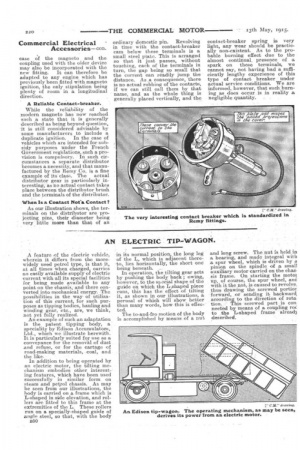AN ELECTRIC TIP-WAGON.
Page 18

If you've noticed an error in this article please click here to report it so we can fix it.
A feature of the electric vehicle, wherein it differs from the morewidely used petrol type, is that it, at all times when charged, carries an easily available supply of electric current with-all its special facilities for being made available to any point on the chassis, and there converted into mechanical energy. The possibilities in the way of utilization of this currents for such purposes as tipping bodies, hauling and winding gear, etc., are, we think, not yet fully realized.
An example of such an adaptation is the patent tipping body, a speciality by Edison Accumulators, Ltd., which we' illustrate herewith. It is particularly suited for use as a conveyance for the remov'al of dust and refuse, or for the cartage of road-ma-king materials, _coal, and the like.
In addition to being operated by an electric motor, the tilting mechanism embodies other interesting features, which have been used successfully in similar form on steam and petrol chassis. As may be seen from our illustrations, the body is carried on a frame which is L-shaped in side elevation, and rollers are fitted to this frame at the extremities of the L. These rollers run on a specially-shaped guide of angle steel, so that, with the body B50 in its normal position, the long leg of the L, which is adjacent there-to, lies horizontally, the short ond being beneath. - In operation the tilting gear acts by pushing the body back ; owing, however, to the special shape of the guide on which the Lshaped piece runs, this has the effect of tilting it, as shown in our illustrations, a perusal of which will show better than many words, how this is effected.
The to-and-fro motion of the body is accomplished by means of a nut
and long screw. The nut is held in a bearing, and made integral with a spur wheel, which is driven by a pinion on the spindle of a small auxiliary motor carried on the chassis frame. On starting the motor up, of course, the spur wheel, and with it the nut, is caused to revolve, thus drawing the screwed portior forward, or sending it backward, according to the direction of rotation. This screwed part is connected by means of a coupling roc to the L-shaped frame alre,ad3 described.






















